-
George Montagu
- and
-
Lamberto Lambertini
It wasn't until the mid-2010s that paywall models in the news industry gained substantial traction. Although leading publishers have been trialling paywall models for much longer (WSJ in 1997, FT in 2001 and switching to metered in 2007, LA Times in 2003, NYT in 2005 with Times Select), the reality is that only post-2008 did they start solidifying. This is in part thanks to three key shifts: the downfall of print revenues, the increased consumer adoption of digital, and the shrinking share of the advertising market by news publishers. Consequently, in subsequent years, a substantial proportion of the industry (especially in Europe and North America) has moved to some form of a digital subscription model - launching metered, freemium or hard paywalls.
At the same time, news organisations have been grappling with pricing their digital proposition. On the one hand, there is very limited variable cost per digital subscription (incentivising low prices) but on the other, there is a need for the industry to have the conviction that their product is worth paying for (higher prices).
With both of these phenomena in mind, we have conducted some research into the paywalls and pricing models of 35 publishers of record across Europe and North America, to better understand where our industry is heading.
A few key trends emerged that we will explore in this article:
- The shift to hybrid and dynamic paywalls is here to stay
- Retail prices (adjusting for inflation) will remain flat or even in decline as large news organisations continue to fight for market share
- There will be a renewed emphasis on maximising the lifetime value of existing, loyal subscribers (e.g. through price increases and bundling) as efforts to attract “fly-by” readers prove ineffective
- Specialist publishers with a differentiated value proposition can charge a premium as general news content becomes commoditised and automated
(Skip to the methodology section to understand which publishers we have picked, our definition of paywall models, and how we examined paywall models).
Sophisticated paywalls take over
Using some of the great work from the Reuters Institute in 2017 and 2019, as well as our own desk research and data, we are seeing not only a shift toward paywall models but a sophistication of those models. The graph below plots the paywalls of the 35 publishers we examined, showcasing 3 clear shifts:
- Free models have fallen to 6%, as digital reader revenue has become a priority. Of those that are still free-to-access, membership or donation models are often used and have been proving successful (eg: The Guardian, Il Post)
- Pure-metered models based on a universally-applied number of free articles have sharply fallen from 35% to 9%, while Freemium models continue to be popular
- Most of those who used metered, have moved to either:
- Hard models (growing by 13%), usually in combination with registration models as a way to unlock a set number of content (like The Economist, The Spectator, Bloomberg) and gather first-party data - Hybrid/dynamic models (growing 10%). This is most prevalent in North America, with dynamic models that lock content and/or showcase different prices based on user engagement (like The NYT (NYT Investor Deck), The WSJ (INMA), or The Globe and Mail (NiemanLab)
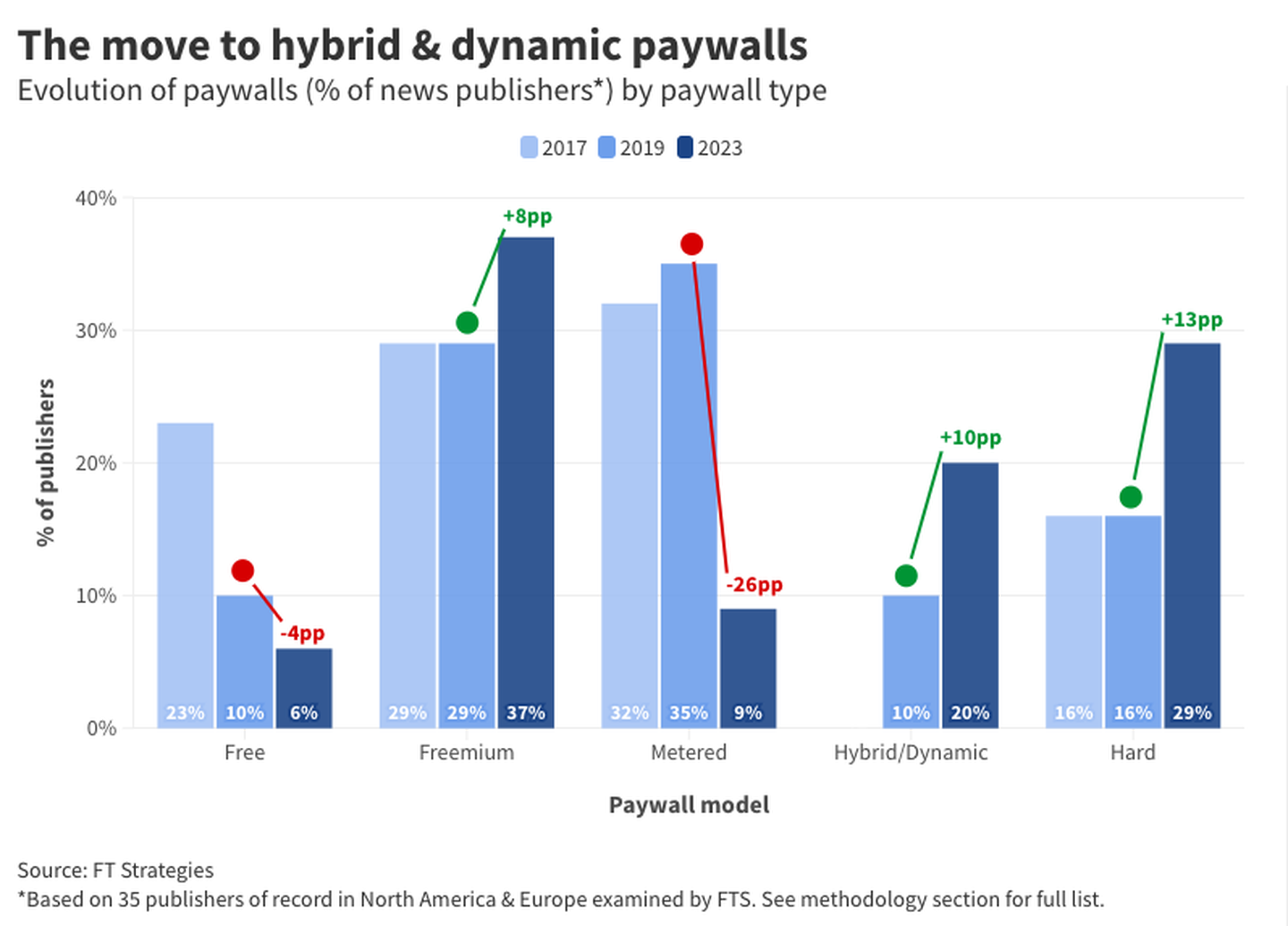




Our findings align with those of Greg Piechota from INMA, who examined a diverse sample of 473 news publishers worldwide. His research also reveals that over time “Freemium is the most frequently observed paywall internationally [and] hybrid models are on the rise”. Interestingly though, he also finds that in 2022 all paywall models performed very similarly in terms of their ability to convert readers [shown below].
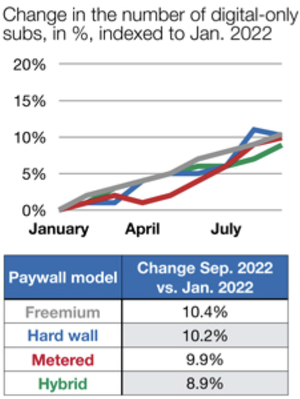




Ultimately, as Greg Piechota points out, paywalls are the final manifestation of your reader revenue, but the connection that you can achieve with non-paying readers before the conversion moment is as important. This includes your brand awareness (via free newsletters, podcasts, events, and much more), your ability to serve specific needs, especially in moments of heightened news cycles, and of course, the pricing of your product packages.
Interestingly, when drawing a comparison between the news industry and the tangentially related but widely regarded as more "successful" OTT streaming sector, a notable disparity arises: none of the prominent streaming services employs personalised or dynamic paywall or pricing strategies. In other words, most consumers would be able to tell you exactly how much they are paying or are expected to pay for their Netflix, Spotify, Disney+, Apple Music, etc. These companies tend to focus less on pricing and more on their value proposition - for example, new features, better personalisation and improved UX.
Of course, there are many potential reasons why OTT has not adopted dynamic pricing (eg: the content itself being of more ‘mass-appeal’ or funding mechanisms either through public markets or as part of large conglomerates that enable OTT companies to keep rock-bottom prices), but ultimately there is a lesson to be learned here regardless. As the news industry moves further into dynamic pricing, it risks confusing consumers' perception of the actual value of news or, more worryingly, implicitly admitting that its products are overpriced.
Let’s focus on pricing in the news industry in a bit more detail.
RRP is in decline and the era of cheap trials
When looking at the pricing of our 35 publishers, the first observation is that the price of digital subscriptions has fallen since 2017 in real terms. The graph below in fact showcases that on average, news publishers are at least £2 cheaper than the inflationary trend. We think this is due to 2 main reasons: (1) most publishers, especially following the increased news interest during the pandemic, are effectively trying to grab market share from competitors; and (2) increased competition for digital subscriptions in both the immediate news industry and the wider media.
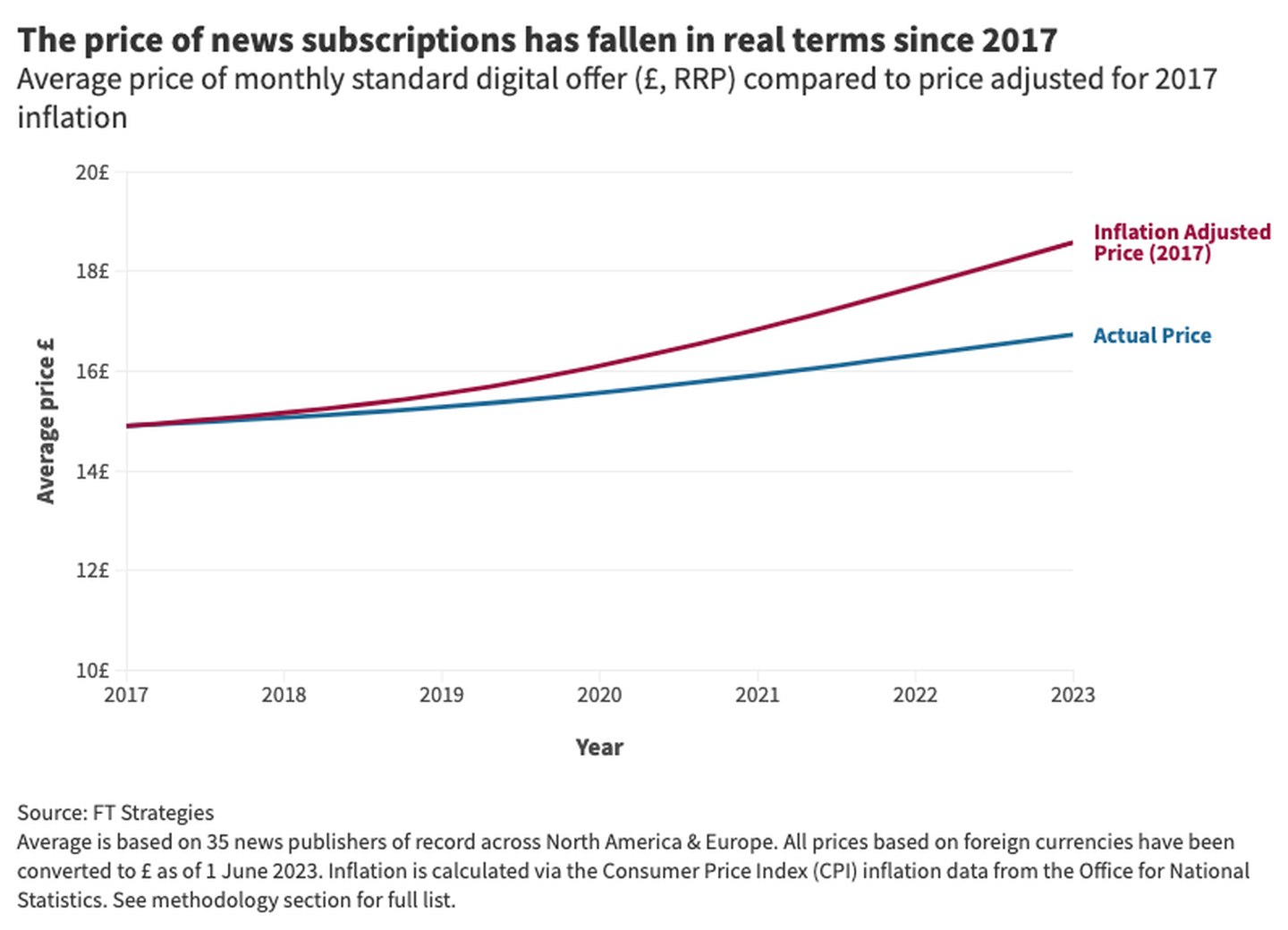




Another important (albeit obvious) point to make is that specialist publishers (like The FT, The Information, or Het Financieele Dagblad) can command the highest prices, as they represent key audience or professional needs and content verticals (read more: Brian Morrissey on B2B’s moment). In fact, organisations such as the FT, are decoupling their B2C and B2B subscription businesses to reflect the differing willingness to pay and price sensitivity of the two groups.
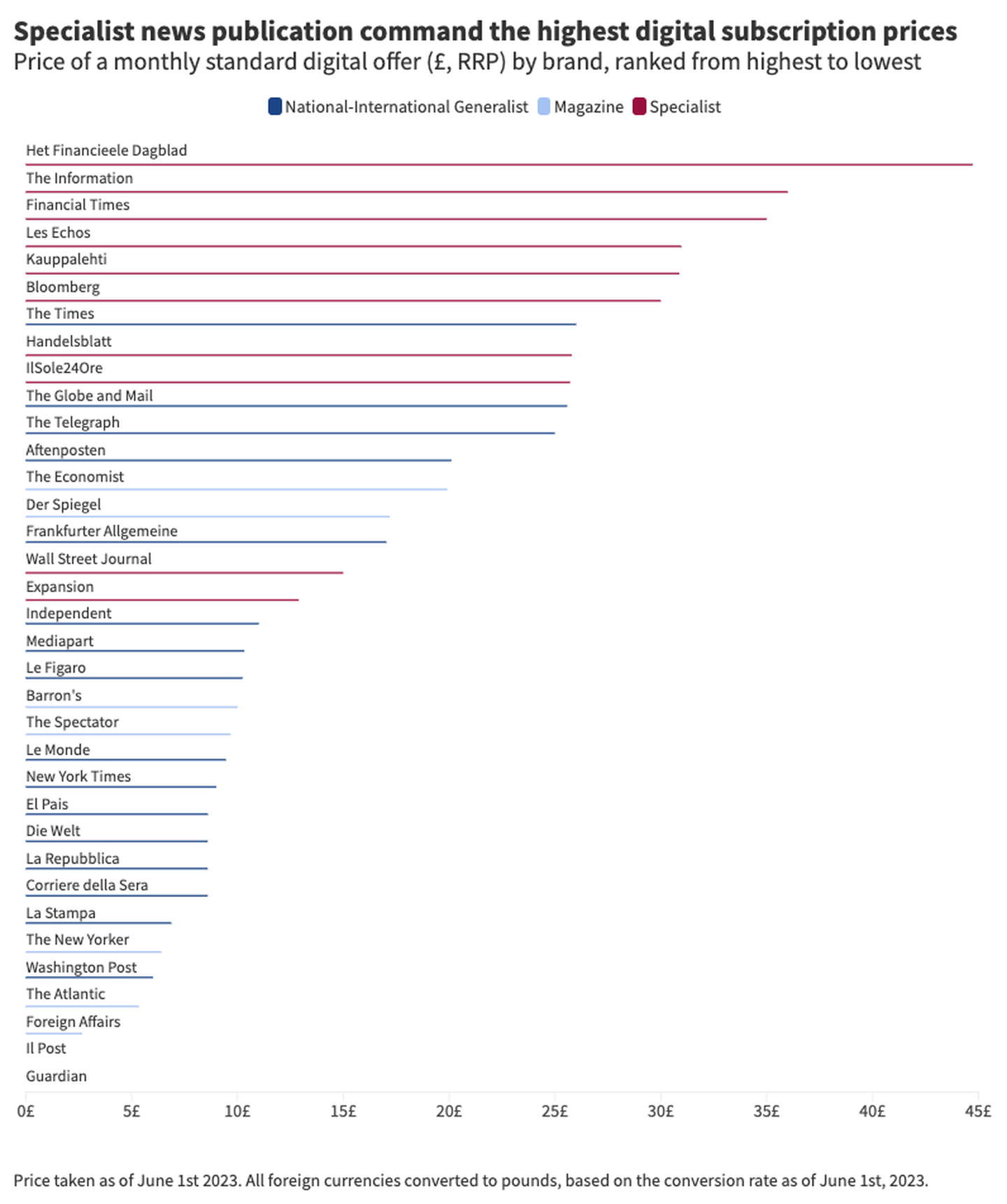




One way that news publishers are looking to convert their non-core B2C audiences is increasing via trials. Of the 35 publishers we examined, 27 had some form of trial (or heavy time-stamped discounting). The length of these trials varies greatly, but the most common is a four-week trial, whilst some publishers (including the Globe and Mail, The NYT, The WSJ, and The Washington Post) offer year-long trial offers as they seek to build habit over a long period of time. Ultimately, whatever your offer, we know that a personalised onboarding experience in the first 30 days of a new user journey is crucial (read more from us here).
However, price shocks (or the ratio between the trial price and standard digital subscription price) could be a fundamental reason why customers aren’t ready to switch to a full subscription (or even initially convert). We found that, on average, the price jump from a trial to a standard digital subscription is 17 times higher. Specialist or B2B publishers tend to have the steepest jump, as they typically have strong brand recognition for that specific content vertical.
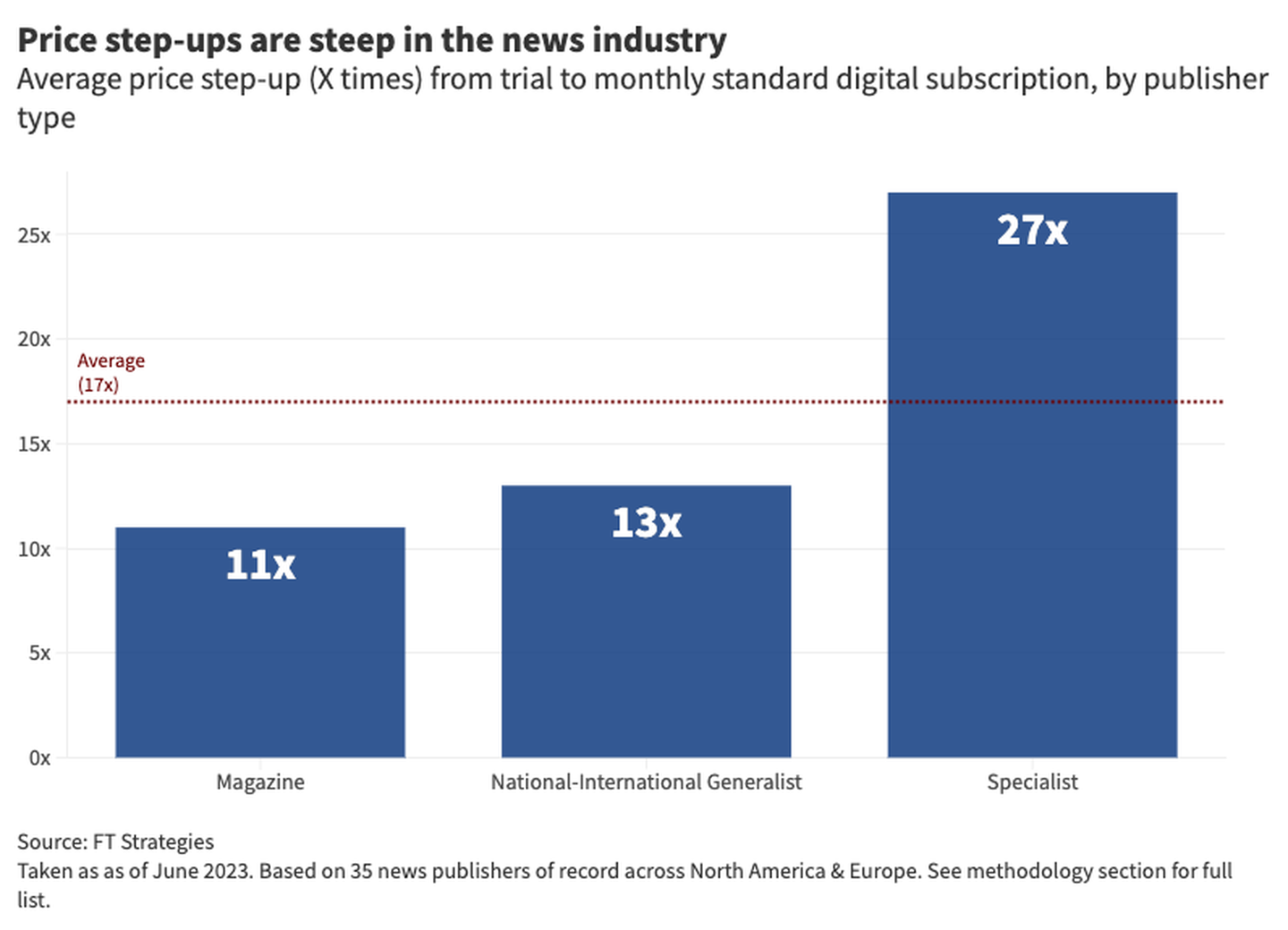




Publishers can fight this in multiple ways:
- Creating a tiered approach to the step-up pricing and clearly communicating it to customers (eg: The Telegraph)
- Use ‘price freezes’, where publishers can keep less engaged users on the same packages (which can be measured via propensity models. Eg: the NYT)
- Create a tiered product offering, where customers can be rightsized to different packages based on their audiences' needs and level of engagement (Eg: The FT with FT Edit)
What does this mean for the news organisations?
- Data will underpin the logic and success of future paywalls - news organisations need to be investing in technologies and strategies that allow them to collect first-party data from their audiences.
- Industry dynamics (generative AI interfaces replacing traditional search, third-party cookie deprecation, and privacy regulation) may mean that data becomes the point of focus for paywalls (as opposed to immediate payment).
- Longer-term trials are likely to persist, although news organisations need to focus on how to demand and justify higher prices to loyal subscribers (through higher-value products - e.g. bundles).
If you’d like to find out more or discuss anything mentioned in this blog, feel free to reach out to me directly.
Methodology
The 35 news publishers of record we examined are:
- Financial Times; Guardian;The Telegraph; The Times; The Economist; Independent; The Spectator; Corriere della Sera; La Repubblica; IlSole24Ore; La Stampa; Der Spiegel; Die Welt; Handelsblatt; Frankfurter Allgemeine; Le Figaro; Le Monde; Les Echos; Expansion; Het Financieele Dagblad; Kauppalehti; New York Times; Washington Post; Wall Street Journal; Bloomberg; The Information; Barron's; Aftenposten; The Globe and Mail; The New Yorker; The Atlantic; Foreign Affairs; El Pais; Il Post; Mediapart
Definition of paywalls:
- Free: All content is freely accessible and nothing is locked
- Freemium: Some content is always free, while premium content is always locked
- Metered: All content is available for a set amount of articles over a set period (eg: 3-5 article per month before locked)
- Hybrid: Uses a combination of metered and freemium to lock content
- Dynamic: Personalised paywalls based on a set of criteria like engagement and propensity to subscribe models
- Hard: All content is locked (with some exceptions for ad-hoc free public service media)
All news publishers pages were checked on the 6th of June 2023 for their pricing offerings. We minimized the effects of seasonal promotions and personalised trials as much as possible by finding the retail price for each publisher and testing pages on various devices. Pages were checked in the UK, which means that different offers could be available based on different geographical locations. To minimise confusion between a trial or discount offering, our definition of a trial/discount is: an always-on but time-bound discounted offering.
Different currencies were all converted based on the conversion rate as of June 1st 2023, namely:
- Euro to Pound: 0.86
- Dollar to Pound: 0.8
- Norwegian Krone to Pound: 0.072


.jpg?width=768&name=928414120.jpg__1440x500_q90_crop_subsampling-2_upscale%20(1).jpg)

